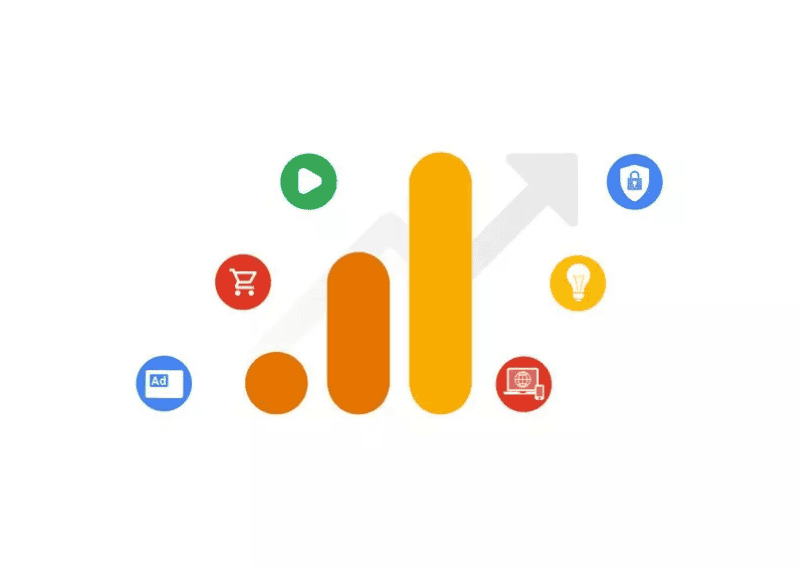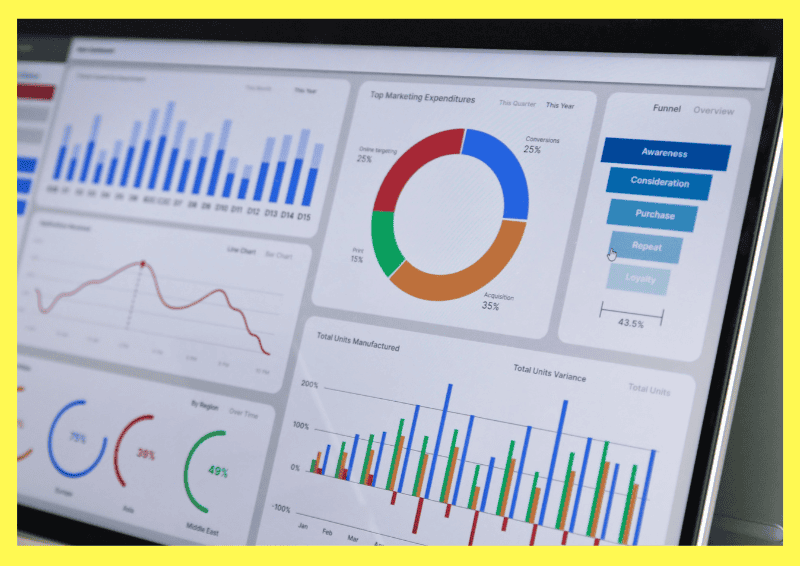
15 Nov Google Analytics: What it is for and how to use it
Index of contents
In digital marketing, understanding and leveraging data is crucial for success. At Algaba Studio, we specialize in helping businesses implement and optimize Google Analytics 4 on their websites. Our mission is to transform data into actionable insights that drive growth. From initial installation to advanced report interpretation, we are here to guide you every step of the way toward an effective, results-driven web analytics strategy.
What is Google Analytics?
Google Analytics is a free web analytics tool provided by Google that allows website and mobile app owners to track and analyze traffic on their platforms.
- Data Collection: Google Analytics collects data on user behavior on a website or mobile app, such as the number of visits, pages viewed, visit duration, the geographic location of visitors, and the device they use.
- Reports and Analysis: The tool provides a variety of reports and analyses that help understand how users interact with the website or app. These reports include metrics like user traffic, visit attribution, conversions, and user behavior.
- Segmentation: It allows data to be segmented by various criteria, such as demographics, behavior, traffic acquisition, and more, to gain a deeper understanding of performance and user patterns.
- Goal Tracking: Google Analytics allows users to set up and track specific goals, such as making a purchase, subscribing to a newsletter, or downloading a file. This helps measure the effectiveness of campaigns and site performance in terms of conversions.
- Integration with Other Google Services: The tool integrates with other Google services, such as Google Ads, Google Search Console, and Google Tag Manager, making it easier to manage advertising campaigns and optimize site performance.
- Customization: Users can create custom dashboards and configure tailored reports based on their specific needs. They can also use advanced segments and custom dimensions for more detailed analysis.
- Evolution and Updates: Google Analytics is regularly updated with new features and improvements. The latest version, Google Analytics 4 (GA4), introduced new analytics capabilities, a unified data model for apps and web, and a greater focus on user privacy.

What can you do in Google Analytics?
Google Analytics offers a wide range of features that help you analyze and better understand the performance of your website or mobile app. Here are some of the main actions you can take in Google Analytics:
Website Traffic Tracking
- Visits and Users: Monitor the number of visits and unique users accessing your site.
- Page Views: Analyze which pages are the most visited.
- Session Interaction Time: See how long users stay and interact with your site.
Audience Analysis
- Demographics: Get information about the age and gender of your visitors.
- Interests: Discover the interests and affinities of your audience.
- Geography: Know the geographic location of your visitors.
- Devices: See which devices (mobile, tablet, desktop) users are using to access your site.
User Acquisition
- Traffic Channels: Identify where your traffic is coming from (organic search, social media, referrals, direct).
- Campaigns: Evaluate the performance of your marketing campaigns.
- Sources and Mediums: Detail the sources (Google, Facebook, etc.) and mediums (organic, paid) generating traffic.
User Behavior
- User Flow: Visualize the path users take through your site.
- Landing Pages: Analyze the pages users enter your site through.
- Events: Set up and track specific events, such as button clicks or video plays.
Conversion Tracking
- Goals or Key Events: Set up and track goals like form submissions, newsletter sign-ups, or purchases.
- E-Commerce: If you have an online store, track transactions, revenue, and other e-commerce data.
- Conversion Funnel: Visualize the conversion process and identify points of abandonment.
Custom Report Creation
- Custom Reports: Design tailored reports with the metrics and dimensions most relevant to you.
- Dashboards: Create custom dashboards to view your key metrics in one place.
Advanced Segmentation
- Audience Segments: Divide your users into specific segments for more detailed analysis.
- Segment Comparison: Compare the behavior of different user segments.
Integration with Other Tools
- Google Ads: Integrate with Google Ads to analyze the performance of your ad campaigns.
- Google Search Console: Combine data from Google Search Console to get insights into your organic search performance.
- Google Tag Manager: Use Google Tag Manager to manage and deploy tracking tags on your site.
Real-Time Analytics
Real-Time Data: Monitor user activity on your website in real time.
Using Advanced Features
- Predictive Analytics: Use predictive analytics to anticipate future user behavior.
- App and Web Measurement: Analyze data from both websites and mobile apps in a single property.

Who Uses Google Analytics?
Google Analytics is widely used by various individuals and organizations looking to analyze the performance of their websites or mobile applications:
- E-commerce Sector
- Knowledge Disseminators
- Content Creators, YouTubers, and Podcasters
- Digital Marketing Agencies and Consultants
- App Developers
- Small and Medium Enterprises (SMEs) and Local Businesses
- Multinational Companies
- Non-Profit Organizations
- Educational Institutions
- Journalists and Media Outlets
- Web Developers and Designers
- Web Analytics Consultants
Practical Examples of Use
- Improving User Experience: Businesses can use Google Analytics data to identify pages with a high bounce rate and optimize them to keep visitors engaged longer.
- Content Optimization: Content creators can analyze which articles receive the most visits and create similar content to attract more traffic.
- Campaign Evaluation: Marketing agencies can track the performance of campaigns on platforms like Google Ads and Facebook Ads, adjusting strategies based on the results.
- Conversion Tracking: Online stores can set up conversion goals to track sales and better understand customer purchasing behavior.

Where Does Google Analytics Store Data?
Google Analytics stores the data it collects from websites and mobile apps on its own servers, which are geographically distributed across data centers worldwide. These data are processed and stored securely in infrastructures maintained and managed by Google.
Google has a global network of data centers designed to provide high availability, security, and performance. These data centers are located in various regions around the world, allowing Google Analytics to handle large volumes of data efficiently.
Google implements strict security measures to protect data stored on its servers, including encryption techniques, regular security audits, and compliance with privacy standards and regulations such as GDPR (General Data Protection Regulation) and CCPA (California Consumer Privacy Act).
Google Analytics automatically anonymizes certain types of sensitive data, like IP addresses, before storing them. This helps protect user privacy and ensures that the collected data complies with Google’s privacy policies.
Website and mobile app owners have control over the data sent to Google Analytics and can configure data retention and other privacy options based on their needs. Google provides tools and settings to manage the privacy and security of the collected data.
How much does the Google Analytics service cost?
Google Analytics offers several service levels, including a free version and a premium version with additional features. Most users use the free version of Google Analytics, which provides a wide range of basic features for analyzing web traffic and mobile apps.
Google Analytics 360 is the premium version of the tool, designed for businesses that need additional features and advanced support:
- Reduced data sampling: Allows for more detailed analysis on large data sets.
- Integration with BigQuery for large-scale data analysis.
- Technical support and assistance.
- Higher data processing limits per day.
- Advanced integrations with marketing and advertising tools.
The cost of Google Analytics 360 is not publicly available and varies depending on the volume of data and the specific needs of each organization. It is necessary to contact Google’s sales team to obtain a personalized quote.
Algaba Studio: Turning Your Data into Opportunities
Don’t wait any longer to unlock the full potential of your website or digital marketing strategies with Google Analytics 4. At Algaba Studio, we are here to assist you with implementation and data analysis, ensuring that every decision is backed by clear and accurate insights. Contact us to explore how we can help your business achieve its digital marketing goals and maximize website performance!






Sorry, the comment form is closed at this time.